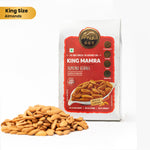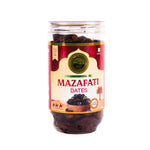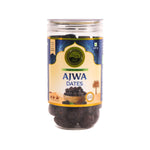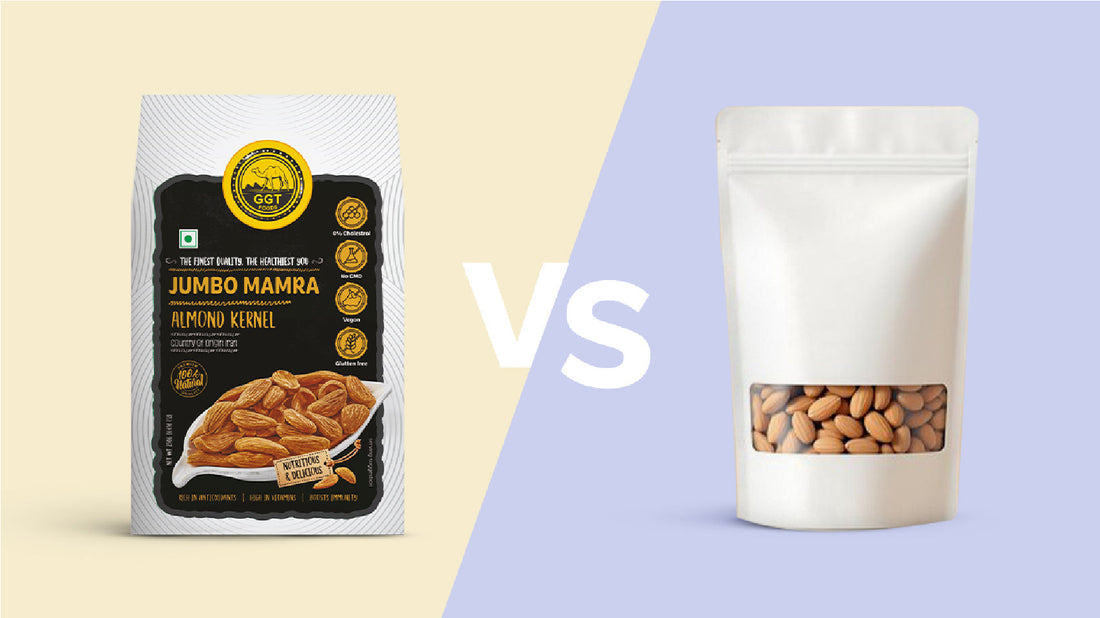Almonds are a powerhouse of nutrition—but not all almonds are created equal. Among the many varieties, Mamra Badam and regular almonds are often compared for their health benefits, taste, and quality. In this blog, we’ll explore the key differences between Mamra Badam and regular almonds to help you make an informed choice.
Basic Overview: Mamra Badam vs Regular Almonds
To understand the difference between Mamra Badam and regular almonds, it’s important to first have a basic understanding of each.
What is Mamra Badam?
Mamra Badam, also known as Kashmiri or Iranian Mamra, is a premium variety of almonds known for its high oil content, rich taste, and natural cultivation. These almonds are typically grown without chemical fertilizers, mainly in Iran and Afghanistan. Due to limited production and high demand, Mamra Badam price vs regular almond price is significantly higher.
What are Regular Almonds?
Regular almonds—commonly known as California almonds—are the most widely consumed type of almonds in India. These are cultivated in bulk, making them more affordable and accessible. They are also pasteurized and often sold with skin or blanched.
Nutritional Comparison: Mamra Badam vs Regular Almonds
Let’s dive into how Mamra and regular almonds compare when it comes to nutritional value:
|
Nutrient (Per 100gm) |
Mamra Badam |
Regular Almonds |
|
Calories |
600 kcal |
575 kcal |
|
Healthy Fats (Monounsaturated) |
High |
Moderate |
|
Protein |
18g |
21g |
|
Fiber |
12g |
12g |
|
Natural Oil Content |
Very High |
Moderate |
|
Antioxidants & Vitamin E |
Very High |
Good |
Mamra almonds contain more natural oils and healthy fats, which makes them more calorie-dense but also nutrient-rich. On the other hand, regular almonds have a slightly higher protein count, making them a good pick for fitness-focused diets.

Mamra Badam vs Regular Badam: Know The Difference
Almonds may look similar at a glance, but Mamra and regular almonds differ significantly in terms of origin, cultivation, appearance, nutritional value, and even how they affect your health. Let’s break down the difference between Mamra Badam and regular almonds across key parameters:
1. Origin and Cultivation
-
Mamra Badam is grown traditionally in the mountainous regions of Iran and Afghanistan, without the use of chemical fertilizers. The yield is low, making them rare and premium.
-
Regular almonds, especially California almonds, are mass-produced using modern agricultural techniques. These are pasteurized as per regulations, which may slightly impact their nutrient retention.
2. Physical Appearance
-
Mamra almonds are shorter, thicker, irregular, and have a rough texture. Their surface is slightly rough, and each almond looks unique.
-
Regular almonds are usually longer, smoother, and in a uniform shape. They have a smooth surface and polished appearance due to processing.
3. Oil and Fat Content
-
Mamra Badam is known for its high oil content—almost double that of regular almonds. This makes them rich, flavorful, and ideal for those who need good fats for skin, brain, and heart health.
-
Regular almonds have a moderate oil content and are drier in comparison. While still nutritious, they don’t offer the same richness as Mamra.
4. Taste and Texture
-
Mamra almonds have a crunchy texture and a distinctively rich, buttery flavor, thanks to their natural oil.
-
Regular almonds are mildly sweet and crisp but less intense in flavor. Some people prefer soaking them overnight to enhance their taste and digestibility. Soaked almonds improve digestibility and reduce heatiness, especially beneficial in Indian climates.
5. Nutritional Value
-
While both almond types are nutritious, Mamra Badam has a higher concentration of healthy fats and natural antioxidants. It is also believed to improve brain function and immunity.
-
Regular almonds provide a good amount of protein, fiber, and vitamin E, making them an excellent option for fitness enthusiasts and daily snacking.
6. Processing & Purity
-
Mamra almonds are unprocessed and chemical-free, often considered the least processed form of almonds available.
-
Regular almonds are pasteurized (as per US FDA regulations), which may involve heating or steam treatments. Though safe to eat, this process can slightly reduce some nutrients.
7. Price & Availability
-
Mamra Badam price vs regular almond price is a key differentiator. Due to its limited supply and traditional cultivation, Mamra is often priced 2–4 times higher than regular almonds.
-
Regular almonds are budget-friendly and widely available, making them ideal for daily use and cooking in larger quantities.
8. Health Benefits
-
Mamra Badam is often recommended in Ayurveda and traditional medicine for boosting memory, enhancing skin glow, and improving stamina.
-
Regular almonds are also healthful but are often chosen for general wellness, weight management, and heart health.
Is Mamra Badam Better Than Regular Badam?
So, is Mamra Badam better than regular badam? The answer depends on your priorities.
-
If you’re looking for premium quality, high oil content, and maximum natural nutrients, Mamra Badam is your winner.
-
But if you're seeking a more affordable, protein-rich, and accessible daily snack, regular almonds make a solid choice.
Conclusion
In conclusion, the debate between Mamra Badam and regular almonds isn’t about which is inferior—it’s about choosing what aligns best with your health goals and lifestyle.
Both Mamra Badam and regular almonds offer impressive health benefits, but they cater to different needs and preferences.
For those who value authenticity, purity, and unmatched taste, GGT Foods Mamra Almonds are a perfect choice. Ethically sourced and packed with care, GGT Foods delivers premium-grade Mamra Badam to your doorstep. Experience the difference—make the healthy switch with GGT today.



![Irani Mamra Almond Oil [Wood Pressed Oil]](http://www.ggtfoods.com/cdn/shop/files/Irani_Mamra_Almond_Oil_150x.png?v=1750315719)



















